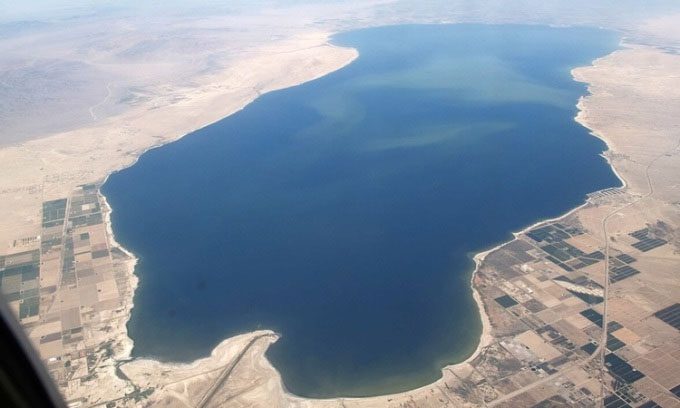Deep beneath the Salton Sea lies the world’s largest lithium deposit, which could transform California into the “Lithium Valley.”
Maria Nava-Froelich, the mayor of Calipatria, California, observes the bubbling geothermal mud at the edge of the Salton Sea. Connected to the Colorado River, the state’s largest inland sea is gradually shrinking and becoming increasingly polluted, leading to the death of many fish populations and threatening migratory birds. However, the vast lithium reserves located over 1.6 kilometers deep below the geothermal mud in the northern Mexican desert and east of San Diego are enough to meet the entire demand of the U.S. and even allow for exports if commercially extracted, according to SCMP.

The layers beneath the Salton Sea contain significant lithium reserves. (Photo: Guardian).
Engineers believe that local extraction processes would have minimal environmental impact, using less water and electricity compared to open-pit mining or evaporation methods. Lithium extraction plants would be powered by geothermal energy, a renewable energy source harnessed when brine is brought up from the earth and converted into steam to turn turbines.
Global demand for lithium, used in batteries that power everything from electric vehicles to fighter jets, is expected to increase fivefold by 2030. The price of lithium carbonate reached a record $86,000 per ton in November 2022, up from $6,000 per ton a decade ago.
China’s dominance over this strategic mineral has spurred the U.S. to race for a foothold in the industry. According to the International Energy Agency, Beijing currently controls three-fifths of the world’s lithium supply and three-quarters of lithium-ion battery production. Other lithium deposits have been discovered in the U.S., including in Arkansas, Nevada, North Carolina, and Utah. However, the only currently active mine in Nevada accounts for less than 1% of global output.
Finding lithium ore in the U.S. is relatively easy. The greater challenge lies in building the industry from the ground up, which includes mining technology, investing in state and federal projects, reducing taxes, and securing research funding. The global battery supply chain is estimated to require $514 billion by 2030 to meet projected demand. The U.S. also faces stricter environmental regulations and community reactions compared to China, particularly concerning lithium processing.
Since the 1980s, hot brine has been pumped from deep underground to turn turbines and generate electricity, but the lithium content was overlooked. The current focus is on extracting this increasingly valuable “white gold” before the pumped brine cools underground. Three geothermal companies—Berkshire Hathaway Energy, Controlled Thermal Resources, and EnergySource Minerals—are conducting pilot projects. EnergySource plans to break ground on a large-scale lithium extraction facility this year. The goal for the three companies is to produce 100,000 tons of lithium annually by 2027, enough to supply 50,000 electric vehicles.

Aerial view of the Salton Sea. (Photo: Wikipedia).
Recently, a new study funded by the U.S. Department of Energy (DOE) discovered that this basin contains even more lithium than previously estimated. The study results indicate there are up to 18 million tons of lithium, rather than the 15 million tons extractable from the Salton Sea, enough to meet U.S. demand for decades, as reported by Mail on December 4. This figure makes the Salton Sea the largest lithium reserve in the world, surpassing even Chile (9 million tons).
Unlike other lithium mines in the U.S., the Salton Sea is a geothermal area containing abundant rare metals, allowing companies to use pressurized steam, which means extracting high-pressure hot water from deep within the Earth and converting it to steam to power electricity generators. Currently, most lithium is extracted from hard rock or underground brine reservoirs. Much of the energy used in lithium extraction and processing comes from fossil fuels that emit CO2. According to the DOE, pressurized steam is more environmentally friendly than other mining methods that require significant water and land.
Initial estimates suggest that lithium extraction will require about 3% of the available water supply in the region. The extraction process involves drilling thousands of meters below the Salton Sea, then pumping the hot brine to the surface. Along with lithium, other metals such as iron, magnesium, calcium, and sodium are also extracted and separated.
- The disaster named lithium: The story of a land with the largest ‘white gold’ mine in the world but is impoverished
- Gigantic lithium mine discovered in the Himalayas, suddenly opening up the future for China’s electric vehicle industry
- Suddenly finding a gigantic lithium mine, India naturally becomes a “giant” in the battery and electric vehicle sector


















































